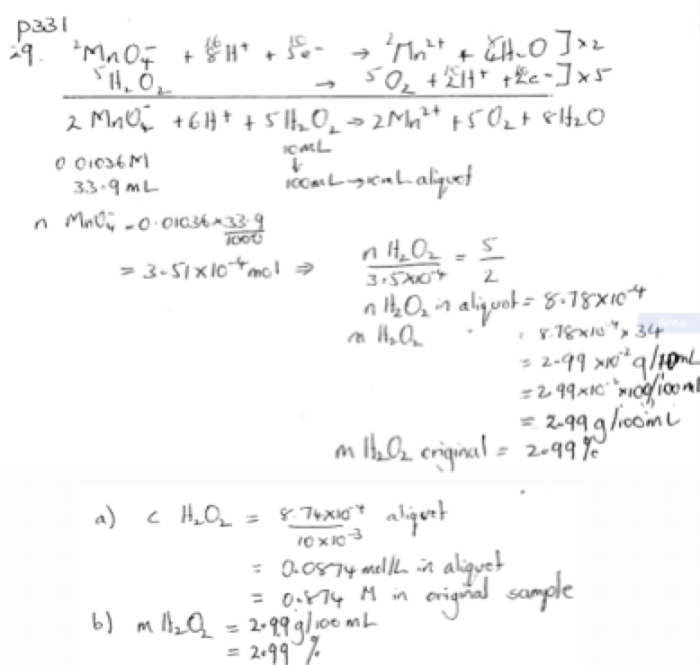Titration hydrogen peroxide and potassium permanganate – Titration of hydrogen peroxide and potassium permanganate unveils a fascinating chemical dance, where the accurate determination of concentrations takes center stage. This in-depth exploration delves into the intricacies of this analytical technique, providing a comprehensive understanding of its principles, applications, and implications.
Unveiling the intricacies of titration, we embark on a journey that elucidates the fundamental concepts, essential equipment, and precise procedures involved in this analytical endeavor. Hydrogen peroxide and potassium permanganate, the key players in this chemical drama, reveal their unique properties and roles, setting the stage for a captivating exploration of their redox interactions.
Titration Basics
Titration is a technique used in analytical chemistry to determine the concentration of a known reagent by reacting it with a known volume of another reagent. The endpoint of the titration is reached when the moles of the two reagents are equal, which can be determined by visual observation or the use of an indicator.
The equipment used in titration includes a burette, pipette, and Erlenmeyer flask. The burette is used to deliver the known volume of reagent, the pipette is used to measure the volume of the sample, and the Erlenmeyer flask is used to hold the sample.
Reagents

Hydrogen peroxide (H 2O 2) is a colorless liquid with a pungent odor. It is a strong oxidizing agent and is used in a variety of applications, including bleaching, disinfecting, and food preservation.
Potassium permanganate (KMnO 4) is a dark purple solid. It is also a strong oxidizing agent and is used in a variety of applications, including water treatment, disinfecting, and deodorizing.
Sulfuric acid (H 2SO 4) is a strong acid that is used to create an acidic environment for the titration. The acidic environment helps to prevent the decomposition of hydrogen peroxide.
Reaction Mechanism

The chemical reaction between hydrogen peroxide and potassium permanganate in acidic solution is as follows:
2KMnO 4+ 5H 2O 2+ 3H 2SO 4→ 2MnSO 4+ K 2SO 4+ 8H 2O + 5O 2
In this reaction, hydrogen peroxide is oxidized to oxygen, and potassium permanganate is reduced to manganese sulfate. The reaction is exothermic, meaning that it releases heat.
Procedure
- Prepare the solutions of hydrogen peroxide, potassium permanganate, and sulfuric acid.
- Set up the burette and Erlenmeyer flask.
- Add the hydrogen peroxide solution to the Erlenmeyer flask.
- Add the sulfuric acid solution to the Erlenmeyer flask.
- Titrate the hydrogen peroxide solution with the potassium permanganate solution until the endpoint is reached.
Endpoint Determination: Titration Hydrogen Peroxide And Potassium Permanganate
The endpoint of the titration is reached when the moles of hydrogen peroxide and potassium permanganate are equal. This can be determined by visual observation or the use of an indicator. Visual observation is the simplest method, and it involves looking for a color change in the solution.
The endpoint is reached when the solution turns from colorless to a faint pink color.
Calculations

The concentration of hydrogen peroxide in the sample can be calculated using the following formula:
Concentration of H 2O 2= (Molarity of KMnO 4× Volume of KMnO 4used) / Volume of H 2O 2sample
The molarity of potassium permanganate can be determined using a standardization procedure.
Applications
- Determining the concentration of hydrogen peroxide in various samples
- Analyzing the purity of chemicals
FAQ Explained
What is the purpose of titrating hydrogen peroxide with potassium permanganate?
Titrating hydrogen peroxide with potassium permanganate allows for the precise determination of hydrogen peroxide concentration in a sample.
What is the role of sulfuric acid in this titration?
Sulfuric acid provides an acidic medium for the reaction between hydrogen peroxide and potassium permanganate, facilitating the proton transfer necessary for the redox process.
How is the endpoint of the titration determined?
The endpoint of the titration can be determined visually by observing the color change of the solution or by using an indicator that changes color at the equivalence point.